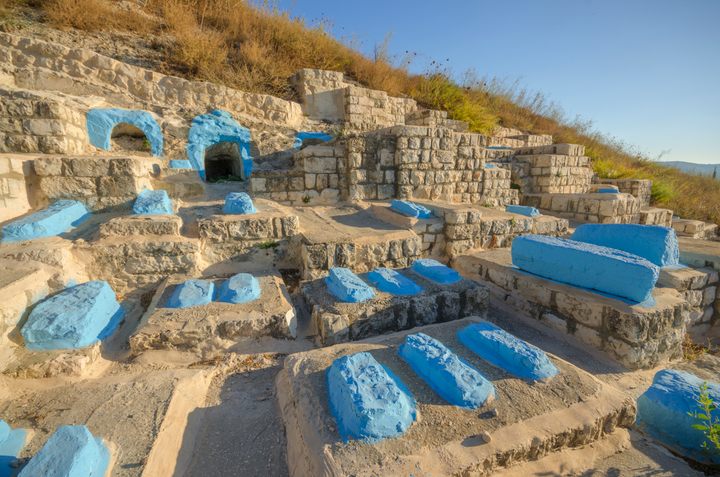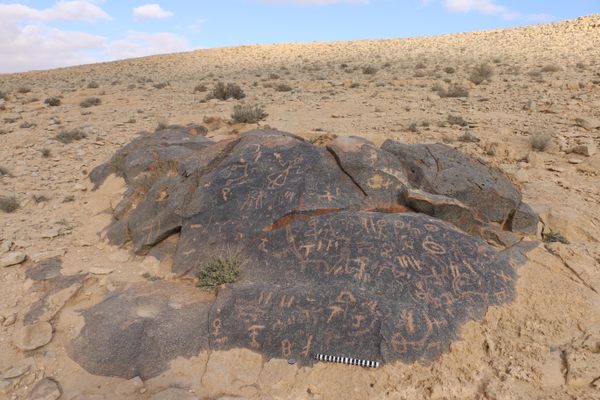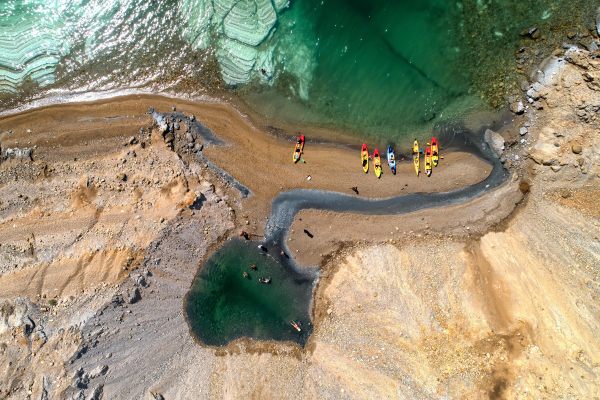
The Bright Blue Graves of Safed Cemetery
Kabbalah mystics lie beneath.
At a graveyard in northern Israel, pilgrims seek to spiritually ascend with the help of Jewish mystic holy men buried beneath bright blue graves.
The cemetery is in Safed, which spent 500 years as a small Galilean settlement before becoming the world capital of Kabbalah, the best-known form of Jewish mysticism, during the 16th century. Thousands of graves and burial caves are carved in the rock. Some of the graves, painted blue, belong to the holy men, tzadikim. According to Jewish faith, a tzadik has no yetzer hara—evil inclination—and he inspires this miraculous virtue in those praying at this grave.
Every year hundreds of thousands of people visit the cemetery from Israel and abroad: pilgrims, secular tourists, the Kabbalah-curious, and once, controversially, Madonna. Most of them come to pay homage to two graves: those of Rabbi Isaac Luria (HaAri, “The Lion”), one of the most revered figures in the Kabbalistic world, and Rabbi Joseph Karo (author of the Shulchan Aruch).
Now, due to the coronavirus pandemic, visitors have deserted the cemetery, leaving a lone archaeologist, Yossi Stepansky, to wander around and converse with the dead.
“I’m in the middle of a fascinating but somewhat morbid project: GPS-mapping more than 120 Hebrew epitaphs from the 15th-17th centuries,” says Stepansky. “It’s weird, spending time among the 40 thousand ancient graves, being by myself with no one around but the ‘Sleepers.’” The inhabitants of the cemetery are known as sleepers due to a Safed belief that their city will be “the first to be resurrected by the Messiah, who will first appear in the upper Galilee.” This contradicts traditional Jewish belief that resurrection will begin on the Mount of Olives in Jerusalem.

With no money available to renovate it, the cemetery has been neglected for years. No one knew the number of the graves, and the records went missing decades ago. In the early 1990s the Safed municipality decided to renovate it by cleaning old graves and roads, building a staircase, and painting selected gravestones blue. When the excavations began, they were in for a shock: Under the paths leading to the famous graves were thousands of other graves, buried under the dirt because of the rains and the sediment flowing down the mountainside.
Aside from the visitors, two locals frequent the cemetery almost every day: Stepansky and David Appenzer, who represents the town’s religious authorities and is in charge of the cemetery’s renovation. They are acquaintances, scions of old Safed families. While Appenzer sees the cemetery as a territory beholden to Jewish law, Stepansky sees it as a world-class, rare open museum under threat of extinction from neglect. According to him, the old Safed cemetery holds “Israel’s largest collection of ancient Hebrew inscriptions, which is also one of largest worldwide.”
In an interview with Jewish TV network Hidabroot a few years ago, Appenzer described the moment of discovering an ancient gravestone as one of “almost indescribable excitement. Out of the tens of thousands of gravestones we uncovered, less than 150 can be identified,” he said. “Most of them are made of limestone and their inscriptions have eroded over the years. That’s why, when you find a gravestone with an inscription, your heart leaps when you see the first letter.”

According to Israeli law, the cemetery is considered an antiquity site, but due to its religious significance it is managed by the Safed Cemetery Foundation. Stepansky fears the repercussions: The hundreds of uncovered gravestones used to be protected in their earthly “tomb,” but are now exposed to weather damage. He wants to document all the gravestones before they crumble away.
So far, only partial archaeological surveys have been conducted in it, documenting about 30 gravestones. “All the inscriptions need to be photographed and sketched, because sketching captures more details than a camera,” says Stepansky. “Afterwards, we send the findings for a paleographic opinion.” No hand-drawn sketch of the inscriptions at the cemetery has been done so far.
In the 1990s some of the gravestones were painted azure, the signature color of Kabbalistic Safed. It looks striking, but affects the preservation process. “My problem is not with the azure, but with the paint,” Stepansky says. “Small details might be erased and become indecipherable during the painting.” Nevertheless, he believes that Appenzer is trying to be as careful as possible under the existing restrictions.

One of the fascinating graves uncovered belongs to Joshua Ibn Nun, a physician who managed to smuggle the writings of Rabbi Isaac Luria and so bring to the world the works of Kabbalah.
After Luria’s death, his most well-known disciple, Hayyim ben Joseph Vital, embarked upon a lifelong mission: Writing down the sermons he and his friends heard from Luria. In 1575, three years after Luria’s death, Vital and the other disciples signed a letter of commitment: “we will not reveal to our fellow men any of the secrets we heard from [Luria] … and we will not be able to reveal it without [Vital’s] permission.”
“According to historical sources of the early 17th century, it was Bin Nun who was first to disseminate the Kabbalistic ‘Lurianic’ writings of Rabbi Vital after bribing Vital’s brother into sneaking a large part them out of Vital’s house,” explains Stepansky. “He had them copied, and distributed to scholars who had been anxiously awaiting them for years.”
Until local COVID-19 restrictions are completely lifted, Stepansky strolls among the “sleepers” with his GPS and encounters a phenomenon he cannot explain. “In the Kabbalists’ plot, where Rabbi Luria’s grave is, the measurement failed completely, and I have to map it manually. The surveyor who came with me couldn’t explain it. It seems like the satellites are refusing to pinpoint the grave’s coordinates, or that the dead are the ones objecting.”













Follow us on Twitter to get the latest on the world's hidden wonders.
Like us on Facebook to get the latest on the world's hidden wonders.
Follow us on Twitter Like us on Facebook